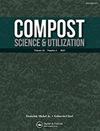Effects of Various Substrates and Supplements on King Oyster (Pleurotus eryngii)
IF 0.9
4区 农林科学
Q3 ECOLOGY
引用次数: 9
Abstract
ABSTRACT This study was conducted to investigate the possible use of prominent agricultural wastes, including wheat and barley straw, maize stem residue, wood chips, sugar beet pulp, and sawdust as basal substrates, as well as wheat and rice bran, soybean powder, and their combinations as food supplements on king oyster mushroom production. A factorial experiment was conducted in a completely randomized design with four replications. The highest yield (2363.2 g kg−1), biological efficiency (236.32%), production rate (225.96 kg day−1), and the shortest pinhead formation stage (10 days) were observed in sugar beet pulp mixed with rice bran. The shortest time for primary fruit body phase (3.66 days) and complete fruit body phase (4.5 days) were observed in wheat straw combined with soybean powder as well as barley straw mixed with some supplements, respectively. Different substrate compositions had significant effects on the growth period, yield, production rate, and biological efficiency of Pleurotus eryngii widely used for nutritional and medicinal purposes.不同基质和营养补充剂对杏鲍菇的影响
摘要本研究旨在研究主要农业废弃物,包括小麦和大麦秸秆、玉米秸秆、木屑、甜菜浆和锯末作为基础基质,以及小麦和米糠、大豆粉及其组合作为牡蛎王菇生产的食品补充剂的可能用途。在完全随机的设计中进行了四次重复的析因实验。甜菜浆与米糠混合后产量最高(2363.2 g kg−1),生物效率最高(236.32%),生产率最高(225.96 kg day−1)。小麦秸秆与大豆粉的配合使用和大麦秸秆与一些补充剂的配合使用分别观察到初级果体期最短的时间(3.66天)和完全果体期(4.5天)。不同基质成分对广泛用于营养和药用目的的杏鲍菇的生长期、产量、生产率和生物效率有显著影响。
本文章由计算机程序翻译,如有差异,请以英文原文为准。
求助全文
约1分钟内获得全文
求助全文
来源期刊

Compost Science & Utilization
农林科学-生态学
CiteScore
4.10
自引率
0.00%
发文量
0
审稿时长
>36 weeks
期刊介绍:
4 issues per year
Compost Science & Utilization is currently abstracted/indexed in: CABI Agriculture & Environment Abstracts, CSA Biotechnology and Environmental Engineering Abstracts, EBSCOhost Abstracts, Elsevier Compendex and GEOBASE Abstracts, PubMed, ProQuest Science Abstracts, and Thomson Reuters Biological Abstracts and Science Citation Index
 求助内容:
求助内容: 应助结果提醒方式:
应助结果提醒方式:


